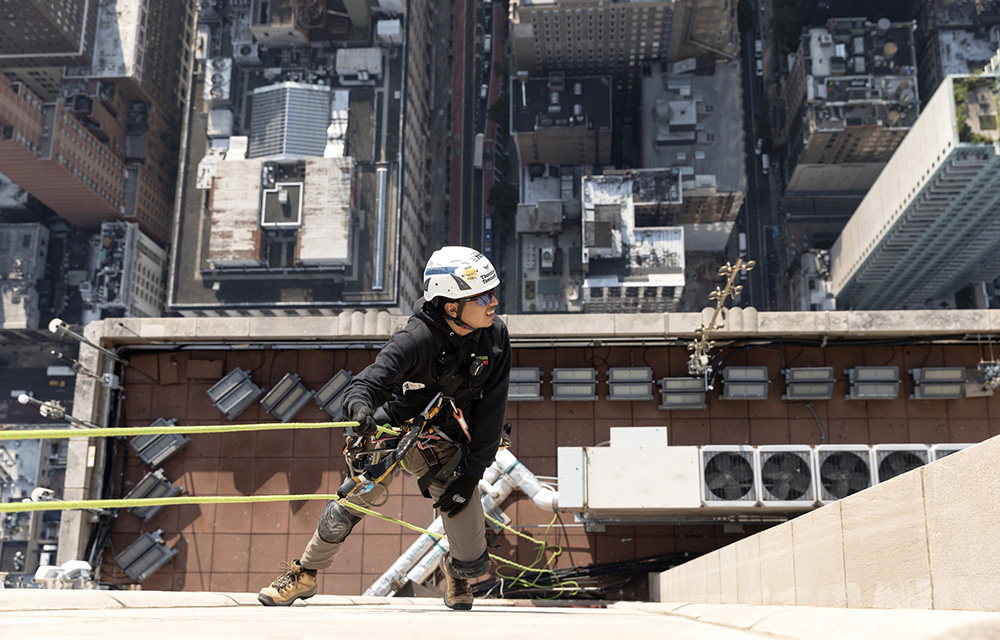News:
Construction Design & Engineering
Posted: February 7, 2011
Deicers and concrete installation: Property owners need to be proactive!
Generally, all deicers work in the same way. They depress the freezing point of ice or snow and turn the mixture into a liquid or slush. Salts cut through ice or snow and form a salt water solution. This salt water spreads under the ice or hard-packed snow and breaks the ice or snow's bond with the concrete surface. Once loose, the ice or snow can easily be removed by mechanical means. In many cases, property owners may apply the material in anticipation of ice or snow. This prevents the bond with the surface and melts the snow or ice as it comes in contact with the brine.
The melting action of the material allows water to enter voids in the concrete. If the temperature then drops and the water freezes, the ice crystals can explode within the concrete surface. This surface defect is commonly referred to as spalling or scaling. 
Preventing the spalling and scaling of concrete begins with the proper installation and finishing of the material.
Ideally, concrete used for exposed slabs should have a minimum compressive strength of 4,500 pounds per square inch and should also have proper air entrainment. 6% air entrainment is common in this area of the country. Air entrainment allows for voids in the material to accept the expansion of water during freezing conditions. Non-air entrained concrete will not have these extra voids and, as such, can spall or scale much more easily. The combination of strength and air is a good defense against deicer and salt damage. Concrete which is ordered, placed, finished and cured properly (for 6 months or more) should resist the effects of contact with deicers and rock salt for years.
In addition to the use of strong, air-entrained concrete, concrete installation should require a level, stable and well compacted sub-base with effective drainage beneath the slab. Allowances for thermal movement, contraction and subsequent expansion can be made by providing joints of required spacing and depth. Sawed or tooled contraction joints should be a minimum of ¼ of the depth of the slab. Grades in the immediate area of the slabs should be set in such a way that surface water is carried away from the slab and the concrete is not withstanding continual saturation.
Many times, concrete surface failures such as spalling can be traced to workmanship deficiencies. The placement and finishing of the concrete is critical. The top surface of the concrete can be severely weakened by poor workmanship. Sometimes workers add water to concrete at the job site, use water as a finishing aid or improperly float the mix. This will dilute the amount of cement at the surface of the concrete and, as such, will weaken the material. The cement itself is the element of concrete that binds the concrete materials. All finishing operations must be performed at the proper time. Any finishing operation should not be performed when free water is present on the surface of the concrete. Adequate curing conditions should be provided by retaining or supplying moisture (and heat in cold weather) for a sufficient length of time. Inadequate curing will prevent the concrete from reaching its full potential with respect to strength and durability. Strong concrete at the surface is needed in order to resist the freeze/thaw action of water. If concrete spalls or scales following the winter season and deicers were not used, it is likely a mix or finishing problem. Concrete testing can verify this.
In summary, when replacing concrete slabs or making repairs to garages, plazas or sidewalks, always provide the contractor with the proper specification of the methods and materials for the project. Use qualified concrete contractors with a proven record. Check the work and the concrete truck tickets to be sure the mix is proper. Only resurface concrete with proper materials, proven applications and surface preparations. Even weather variables will impact the final product- temperature, humidity and wind greatly affect the end product and should be properly monitored and installation methods adjusted accordingly.
As a rule, or at least as a precaution, new concrete should not be treated with deicers during, at minimum, the first 6 months following installation or before the first winter. Furthermore, salts may be harmful to lesser quality concrete at any time if temperatures are or will be below 20 degrees F and, as a result, other products should be considered. Monitoring and removing the ice and snow after the deicers have done their job will allow the concrete to dry out. Dry concrete will be less likely to be damaged by freeze and thaw cycles. Consider stepping up your snow removal services to achieve this and consider using sand to achieve traction.
Andrew Amorosi, PE, RS, is principal of The Falcon Group, Bridgewater, N.J.
MORE FROM Construction Design & Engineering
NYC mayor and DOB release comprehensive façade inspection and safety study conducted by Thornton Tomasetti
Manhattan, NY New York City mayor Eric Adams and New York City Department of Buildings (DOB) commissioner Jimmy Oddo released the full recommendations from a comprehensive engineering study conducted by global engineering firm Thornton Tomasetti








.gif)
.jpg)

.gif)